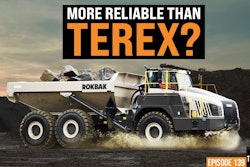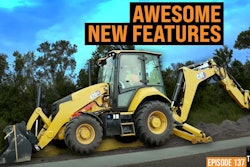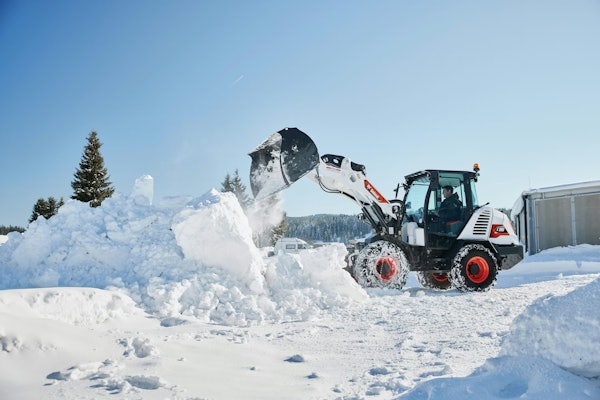On this episode of The Dirt, host and equipment operator Bryan Furnace tests out John Deere’s new 350 P-Tier excavator.
Bryan gives his review of the excavator, pointing out several improvements made to increase machine life, make maintenance easier and make the operator more comfortable.
The undercarriage also gets heftier components for owners who want to go beyond the 15,000- to 20,000-hour mark. “It’s really nice to hear a manufacturer thinking about longevity on their machines,” he says.
He also found it had no trouble getting heaping bucketfuls of hard, blue clay.
“This is a great machine.”
The 40-ton 350 was one of the first excavators to come under Deere’s new performance tier naming strategy. The P-Tier is the next level above the base G-Tier machines and comes with upgraded technology, safety and comfort features.
The 350 runs on a 271-horsepower Deere engine, and the company offers a variety of 2D and 3D SmartGrade control options. Bryan tested SmartGrade with grade and slope control and offers his views.
Some quick specs on the excavator:
- Max dig depth: 26 ft. 10 in.
- Dump height: 25 ft.
- Max reach: 36 ft. 5 in.
So to find out why Bryan says the 350 P-Tier is a great machine, check out this episode of The Dirt.
Equipment World serves up weekly videos on the latest in construction equipment, work trucks and pickup trucks – everything contractors need to get their work done. Subscribe and visit us at equipmentworld.com!
In This Episode:
- 00:00 - John Deere 350 P-Tier Excavator Review
- 00:47 - Exterior: Bucket Bushings and Pins
- 01:34 - Exterior: Lubrication Points
- 02:06 - Exterior: Undercarriage Improvements
- 03:03 - Exterior: Cooling Package Design
- 04:07 - Interior: Cab Design
- 04:58 - Interior: Screen Size
- 05:58 - Interior: Operator Seat Comfort
- 06:55 - Performance
- 07:39 - Machine Control Overview
- 10:47 - Machine Control Feature: Bucket Angle Hold
- 11:45 - Machine Control Feature: Slopes
- 13:35 - Machine Control: Room for Improvement
- 16:06 - Final Verdict
Bryan Furnace (00:00):
This Equipment World video is brought to you by Chevron Delo 600 ADF ultra low ash diesel engine oil. It's time to kick some ash. Today, we're here to talk about the new John Deere 350 P-Tier Excavator. What do we mean by P-Tier? Well, P-Tier is essentially John Deere's newest iteration of their machines that come with all of the latest, greatest technology.
(00:25)So, if you're looking for something more than just the base model machine, that's when you step up to the P-Tier and you start getting into machine control, you start getting into depth limitations, you start getting into some of the technology side of the business. Now, that being said, let's get into the P-Tier and let's talk about some of the things we liked and disliked about the machine.
(00:47)So, the first thing I'd like to get into is really, we're moving to an era where I have to break these reviews down into two parts. There's the machine itself and the base excavator, and then there's the technology component. And so, we're going to start with the basic machine. So, starting with some of the improvements John Deere's made to the 350 P-Tier, we're going to start down where the bucket connects to the stick. Your main pins there now have a new set of bushings and hardened pins, which means you're going to get longer life out of those pins.
(01:15)And since there's bushings, instead of you having to line bore the stick when everything gets wallowed out, you can just replace the bushings for a far cheaper price to continue to maintain the machine. It's a really nice improvement. I'm looking forward to the fact that John Deere's doing this. Hopefully, more manufacturers follow suit, so that it's a little more affordable to keep your equipment running long term.
(01:34)Now, another improvement John Deere has made is moving the physical location of the zerk fittings to grease your bucket pins.
(01:39)So, now instead of them being tucked right up against that pin like they are on a lot of competitors, where they get totally filled with dirt and they're difficult to get clean enough that you can get a good seal with your grease gun, they've actually moved them up on the stick, common to what you'd see in a bigger excavator, so that they're a little up out of the dirt, they stay clean and they're much easier to grease. Another really nice improvement, small but very nice for you as an operator as you go to do your morning checks and your morning greasing.
(02:06)Now we start getting into some of the improvements John Deere has made to the actual undercarriage of the machine. John Deere noticed that they had a fair amount of users that were pushing their excavators to 15 to 20,000 hours and they were starting to have some components fail on the undercarriage just because they weren't quite beefy enough for that long of a life. John Deere has responded and beefed up some of the undercarriage components.
(02:26)For instance, the rails that keep your idlers nice and tight so that they continue to not get as much track snaking as the machine gets older and starts to wear out. These have been beefed up. Again, thinking about the long-term customers. And I have to say, it's really nice to hear a manufacturer thinking about longevity on their machines. Rather than just improving something for the temporary, John Deere's actually going that extra step to make sure that your machine's going to last for a long time without having to do unnecessary, really expensive undercarriage replacements.
(03:03)Now, one of the areas that I could see John Deere improving on when it comes to just the overall base machine is the cooling package. Now, it is really nice to access. They've actually changed the door to where instead of it being slats where debris can get pushed into your cooling stack and can't necessarily make it back out again. They've actually changed it to a one-piece door where it is stamped with tiny holes. And the John Deere rep was telling me that those holes are sized specifically that if a particle can make it through the holes in the side of the door, it can make it all the way through the cooling stack.
(03:34)Now, that doesn't change the fact that over time, you're going to have coolant leaks, hydraulic oil leaks, things that are going to cause dust to actually stick to those cooling package fins and we're going to have to get in there and blow those out. And that's where I can see a slight bit of room for improvement from Deere is currently the only way to do anything in between the cooling stack is to go up on top of the machine.
(03:54)There's no way to swing anything out of the way. There's not really good access from the ground to blow all the way through your cooling stack and down in between the cooling package. Not a huge thing, but at the end of the day, I could see some improvement there.
(04:10)Now, moving into the cap, this is where we get into my biggest critique with John Deere, and this is no problem with John Deere. This is just we all have our preferences. And to me, the knobs over here on the right-hand side just have always felt a little dated. They don't feel as nice and fancy and futuristic as some of the other manufacturers.
(04:28)The rebuttal to that is you get in a John Deere machine and it doesn't matter if it's one of the current years or it's a seven-year-old model, you're not going to fumble your way around the cab trying to figure out where everything is. If you're familiar with a John Deere's cab layout, you're going to know exactly what all of those knobs and dials do. So, it's really more of a critique of me being a princess than it is John Deere actually having something wrong with their cab.
(04:54)Now, one area that I will say I would love to see John Deere improve upon because I do feel it is a shortcoming is the size of the screen. We're now moving into the era as you've seen on all other machines and really even John Deere's previous model machines, where you have backup cameras. And now we don't even just have backup cameras. Coming in line with all of the other manufacturers, John Deere offers a 270-ish degree camera view where you can see both sides of the machine and out the rear of the machine. Well, that's fantastic assuming you have a decent-sized screen that you can make sense of that information.
(05:27)Now, I understand not wanting to get in the view of the operator and all of that, but at the same time I do feel like they could pretty significantly increase the size of that screen and it wouldn't really be detrimental to the operator. Most of the competitors have a bigger screen in the cab and it hasn't really interfered with my work on the job site, but it does make for an overall better experience when trying to navigate your menus and more importantly, look at those cameras.
(05:55)Now, I have to say one thing I absolutely loved about this machine is John Deere has taken a note from the auto manufacturers and they have put a new seat in this machine that first of all is unbelievably comfortable. But more importantly, and what I love as a princess operator is it now has heating and cooling, but not just on or off like so many other manufacturers are. John Deere has actually created the ability to where you can select between three settings for your heat cooler or your heat warmer. That's fantastic because in the summer months, I don't necessarily want my butt getting blasted at full bore with the air conditioning.
(06:31)And similarly, when we're in the dead of winter after my cabs warmed up, I don't need the seat heater on full blast roasting my behind. Maybe I'd like to tune it down a little bit. And up until now, that hasn't really been available to us in the construction world. But thanks to John Deere's improvements on their seat, you now have more customization when it comes to the comfortness of your bum.
(06:54)The actual performance of the machine, loved it. It was a very powerful machine and we'll get into really where it impressed me here in just a little bit. Now, the one critique I have on the power of the overall machine is the slew motor seemed just the hair on the slow side. Wasn't bad, but it did seem just a little sluggish. But the actual pulling power of the machine and digging power of the machine really blew me away because we were in very, very hard clay. It was no problem whatsoever for this machine to grab a full heaped bucket and move it around the job site.
(07:24)And you guys can see this is that nice thick blue clay. It's delicious to dig in, but this machine's pulling through it just fine, including with grade control.
(07:37)Now, this is where we bridge over and we stop talking about the base machine and we start getting into the technology component. And it's funny because these reviews are slowly becoming more about the technology component and less about the base machine. So, let's get into it.
(07:51)But before we get into that, I want to take a second to tell you about the sponsor of this video, Chevron lubricants. Protecting your diesel engine and its exhaust after treatment system has traditionally been seen as an either/or proposition when it comes to choosing the engine oil that's going to protect your system. And that's exactly why Chevron spent more than a decade of R&D work developing a no compromise formulation.
(08:13)Now, I don't have to tell you why a clogged DPF is bad news, but here's the real kick in the pants. Ninety percent of that ash clogging up your DPF and then upping your fuel and maintenance cost, it comes from your engine oil. You might be thinking, "Why don't they make an engine oil with less ash in it then?" You'll be happy to learn that Chevron agrees with you. They've developed a new ultra low ash diesel engine oil that is specifically designed to combat DPF ash clogging.
(08:39)Delo 600 ADF with OMNIMAX technology cuts sulfate ash by 60%, radically reducing the rate of DPF clogging and extending the DPF service life by two and a half times. Before, you had to choose between protecting your engine or your aftertreatment system. Now, you don't. Delo 600 ADF with OMNIMAX technology. It's time to kick some ash.
(09:05)John Deere has equipped the 350 P-Tier with the smart grade system. The smart grade system is John Deere's partnering up with Topcon in offering machine control in their excavators, which now means that all of the features you see on some of the competitive machines are available on John Deere equipment.
(09:22)Some of the features you might get out of an iDig system, you no longer have to go to a third party for. They're built into the machine through this Topcon interface. Now, it's a really nice interface. There's not many buttons on it. It makes it pretty intuitive. I was able to fumble my way through the system without too much guidance from the Deere representative.
(09:40)The nice thing about this particular machine is I don't have to necessarily do anything on the screen. I can set up my increments and decrements within the screen and then that's all controlled right here with this toggle and I'm jumping up and down by X amount of tens or feet, whatever you have it set to. And then I can actually benchmark with this button right here at the top. So, we're going to benchmark.
(10:03)We were digging in extremely hard clay and this system kept grade within a few hundredths for my entire pole.
(10:10)Okay. So, now what we're going to do is I'm going to get to here and I am no longer going to mess with my boom control. So, I'm sitting right about grade right here. So, I'm going to start pulling with just my stick and you can see the machine is carrying grade. And we are within a couple hundreths. I mean, this is doing in this hard clay. That's what's impressed me about this machine is it is maintaining grade within a couple hundredths even in the hard clay and you're not getting a lot of bouncing and chatter like other systems, which has been really impressive.
(10:46)Another cool feature this machine has is it will hold your bucket angle of attack. The way I do that is I'm going to hold my trigger over here on the right-hand joystick and I'm going to pull my toggle down. And that is going to turn on and off the bucket angle hold.
(11:02)So, let's say we want to do a nice little cleanup pass, keep a nice flap bottom. I'm going to set my bucket down in this orientation. We're just going to pull with the stick. We're not going to mess with the boom. I'm about two-tenths above grade right now. So, the machine's going to fight to get down and you're going to see it start to cut a little bit. And there it is. We have a nice, beautiful, flat bottom to our trench and I had to put zero effort into that.
(11:28)And so, as a production operator, this is where machine control really comes into play. I'm not relying on the machine to baby me and coddle me, but what I am relying on the machine to do is make me more efficient on my finish passes.
(11:41)So, there's another scenario where as an experienced operator, machine control can be very, very convenient. So, let's say we've got a scenario like this to where I need to go from the bottom of my trench up to where my tracks are and I want to do that at a consistent slope. There's a couple ways we could have done that.
(12:00)In the past, it's one, I can eyeball it as an operator and hope we get pretty close. The other one is I can call my grade checker over. We can take some measurements and then we can do a calculation and then I got to have my grade checker here helping me. Instead, with machine control, we can do this all on the fly. We can pick an arbitrary slope and decide to do that.
(12:16)So, what I'm going to do is in my system, I'm going to go to menu. I'm going to go to measure slope and it tells me, "Put your bucket at the first point and push okay." So, I'm going to reach out here and I'm going to get it in position. We're going to push okay. The machine's going to take a measurement and then it says, "Get to your second point." So, we're going to go to our second point back here. We're going to put our teeth right where we want to end this trench, which is going to be right about here. I'm going to push okay.
(12:43)And what happens is the system automatically programs in a slope, but it doesn't know exactly how high it needs to be or what direction we want to face. It just knows that we've measured the slope. So, now what it wants us to do is make sure that the machine is in line, so it wants us to zero our compass.
(13:00)So, we're going to reach all the way back out here. I'm going to zero my compass. And then I'm going to zero my bucket. And now we are exactly where we need to be. And so, now I can just pull back on my stick and it's going to start pulling that grade. So, as you can see, we didn't have to get a grade checker. I didn't have to do any guesswork. And now, we've got a ramp going straight down into that trench. That was an arbitrary slope that we just pulled out of our behind.
(13:34)Now, my first issue that I had with the system is it's not quite as intuitive as to when the machine control is going to take over. Now, switching the system on and off is very easy. It's a click of a button on one of your joysticks and your automatics are on or off depending on how you have it set.
(13:50)I have a trigger on my left-hand side. If I click that, my autos are now engaged. I can continue to dig like normal until I get down to grade.
(13:58)Now, what happens is the machine, as you're digging down into your trench, you'll only pull back with your stick. And when you're pulling back with your stick, the machine is going to pick up that you've reached grade assuming your automatics are engaged, and then it's going to just continue to pull that grade and it will control the boom function on its own.
(14:17)Now, this is one of my small critiques on this. If you grab the boom stick, your physical control stick in the cab for the boom, if you grab that and manipulate it at all, it kicks the automatics off. Well, as an operator, that's frustrating because I may want to dig a little closer into the machine, which means I'm going to be sticking in and I'm going to be booming down at the same time.
(14:38)And as soon as we hit grade, I let go of my boom function because I think the machine has grabbed grade, knows that we're there, I'm within a tenth, we're within our magic window that's supposed to snag. And then I start to pull, only to look over and realize that I'm digging four to five inches below grade. I know the rebuttal to that is spend a couple days in the cab and you're absolutely going to find that sweet spot to where they engage, you know the machining, you get good at it.
(15:03)The automatics overall were phenomenal. The only other problem I had with the system seemed to be a little software glitch to where if I had a benchmark set in the system, I went and re-benchmarked and added in some sort of a slope. The system would see my new benchmark, it would see my slope and it would set it up on the screen, but my automatics would still indicate that I was above grade.
(15:25)Now, I'm going to do a pull. Why is it not picking up that slope?
(15:36)And the only way I could overcome this is I would have to go in, re-zero out my benchmark, re-zero out my offset, and then re-set my offset, re-benchmark the machine, and now all of a sudden, the automatics would pick up on the fact that we've actually changed grades.
(15:53)Now, it's working.
(15:54)And I can absolutely see an update coming down the road because really in my mind, this is a software issue.
(16:03)All of that being said, my overall take on the machine was this is a great machine. I would absolutely go and buy this for my job site and rest confident knowing that you have John Deere services support behind you. The flip side is you just have a few quirks that you're going to have to work through with this machine and some of the software.
(16:20)So, that being said, as always, I hope this helps your business. Thanks to the folks out at John Deere for letting me come out and run this machine. We'll catch you guys on the next episode of The Dirt.










